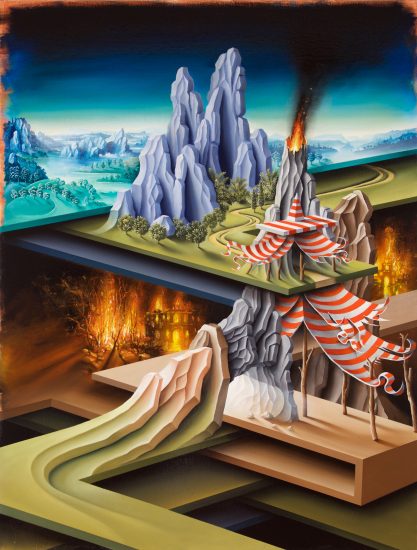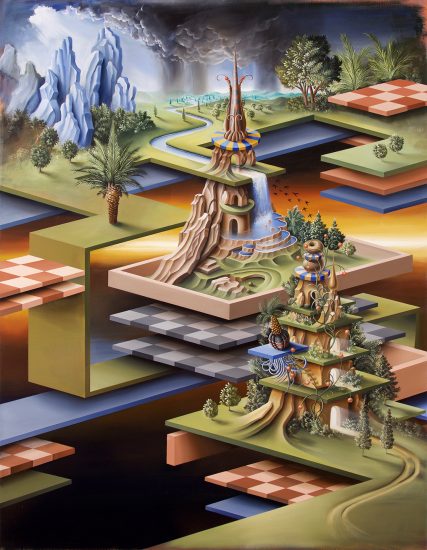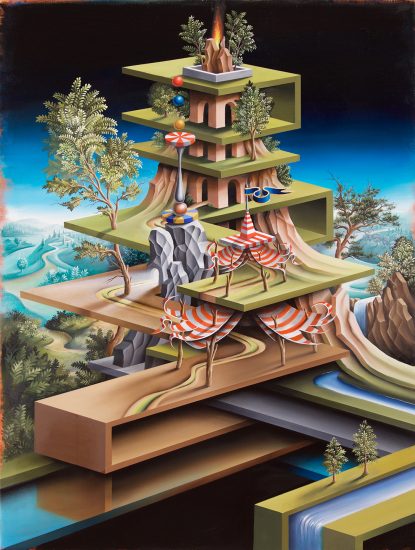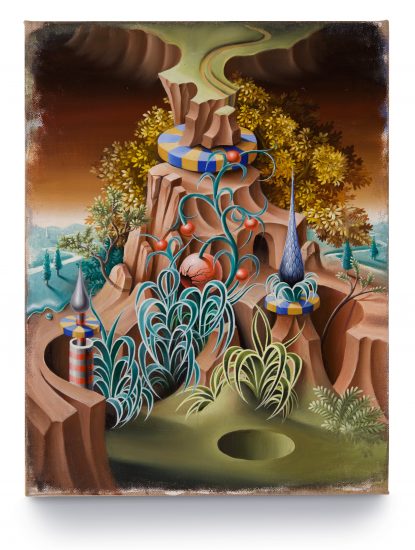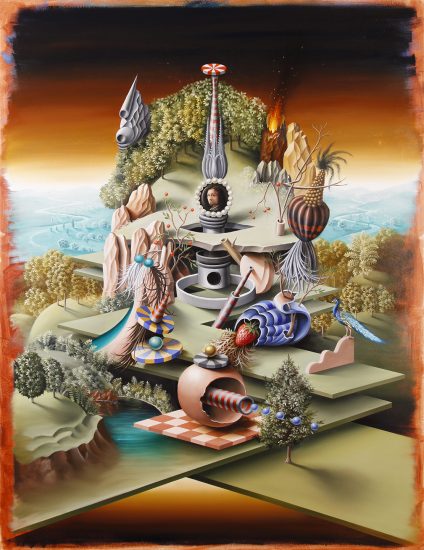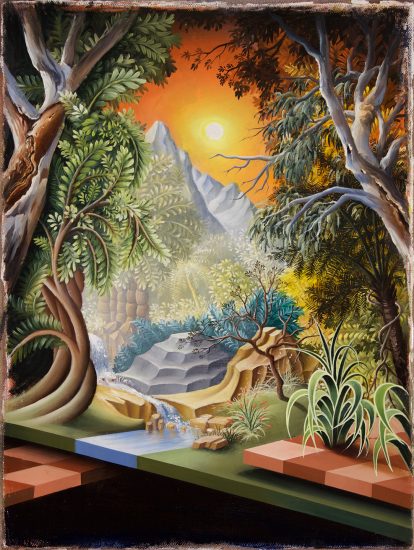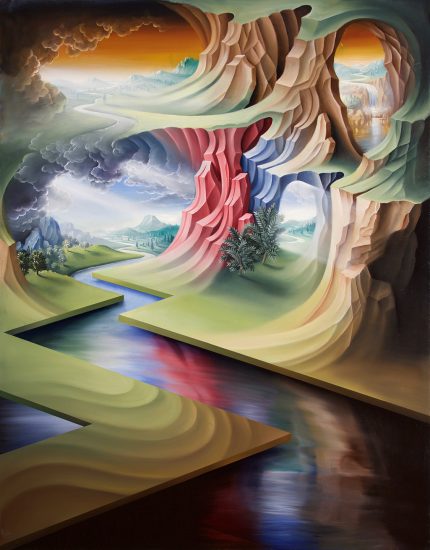On the eve of his show with ARC One, Peter Daverington discusses his new body of work, the eternal symbol of the mountain and the will to bad taste…
Andrew Frost: I first became aware of your work when I saw three paintings in the Art Bank collection. I was really struck by the precision of the work but also how ‘out of time’ they seemed – the are their own painting world. I was reminded of the American abstractionist Al Held but there were also hints of op and what appeared to be references to a European landscape tradition. That latter thread seems to be a big part of this new work. What draws you to 16th century Northern European fantasy landscapes?
Peter Daverington: I have been studying the development of landscape painting for many years now. I became curious of how humans have evolved a pictorial language to describe their environment, their surroundings and their world. There is a long trajectory which is fascinating and too complex to map out here but in short I am intrigued by the 16th century for its particular stylization of landscape. Its not naturalistic and doesn’t conform to any kind of realism or photographic perspective. It is simply a unique pictorial space that belongs to the language of painting and the imagination. I used to think that these paintings were kind of naive but I was wrong. They are intentionally stylized and this is what I love about them. There is a strong connection between 16th century European landscape painting to that of Chinese painting and Persian miniatures that I am researching and exploring in my work. It is not really discussed at all in the history books.
AF: Could you talk about the title – what’s the reference and what does it mean for you?
PD: Weltlandschaft is German translating as Worldlandscape in english. It was coined in the early 20th century to describe a genre of painting particular to 16th century northern Europe where landscape became the central subject of the picture. These types of landscape paintings were largely imaginary and had elevated viewpoints with seemingly infinite horizons. They are kind of like pictorial maps that showed oceans, lakes, rivers, highlands, lowlands, sky, cloud formations, buildings and pathways. They are Landscapes of symbols whose famous exponents are Joachim Patinir, Albrecht Altdorfer, Pieter Brueghel the Elder and Hieronymus Bosch.
AF: Why mountains?
PD: I love nature and I love mountains but that isn’t really why I paint them. Mountains are phenomenal forms of nature and endlessly curious to me as sculptural forms. The way light interacts with the complex geometry of mountains is something I will never tire of. Mountains are mystical and in this way become archetypes for a spiritual longing common to all people from all periods.
AF: It’s interesting you should say that. Are you aware of the video game ‘Mountain’? It’s a like an art work – there’s very little interaction in the game which is basically a mountain floating inside a bubble in space, yet it has this incredible presence. Do you think these kinds of classically sublime subjects have a meaningful contemporary context?
PD: No, I’m not aware of it. I am not aware of any games actually apart from those 80’s games like donkey kong and pac man. But it does sound like something id like to see. I did an animation work called ‘Arcadia’ you might want to check out. Its a 3D fly through of one of my paintings where a mountain grows out of a hypercube. I think science is raising very interesting questions about the nature of reality and Quantum Physics is at the forefront in expanding our world view. There is a curious relationship developing between ancient mysticism and cutting edge science. If you ever want to read something on this a great place to start is a book by David Bohm, ‘Wholeness and the Implicate Order’.
ARCADIA (trailer) 2012 – Peter Daverington from Peter Daverington on Vimeo.
AF: What are the details that you’ve included in the paintings? A work like Jacob’s Tent seems to have some interesting allusions but I’d be intrigued to know what you’re own process is in budding a picture like this.
PD: Many of these new works have a dwelling included in the landscape. A cubby, a hut, a cave or a tent, these are places we can all relate to. Although I never intend it I find my pictures end up having these biblical narratives running through them, at least one can interpret them as such. I think its because when you deal with archetypes of the collective imagination timeless stories emerge that cross borders between cultures, religions and time periods. I never plan my paintings or make preparatory sketches. I build them up form by form over time. They are intuitive yet formal compositions where every element is an integral part of the whole…like a still life or a stage set.
AF: I’m intrigued by the layering of interlocking landscapes – they remind me of architectural views but also of virtual worlds and gaming. Were those reference points for you? And what do they mean in your work?
PD: My primary preoccupation in painting is in grasping three dimensional space. You know… trying to make sense of how we see and how optics determines the way we translate and understand space. So I became a student of perspective and made many paintings exploring the evolution of geometry and the illusion of three dimensional space. So I guess there will be an inevitable cross over with architectural design and digital video game graphics even though they are not primary interests of mine. For this new body of work I have departed from linear perspective to explore isometric projection which I feel is more egalitarian…everything can have its equal place in the composition – it allows for the eye to see more and you can include more. I noticed that Chinese and Japanese painting understood this very early on as did the ancient greeks and early renaissance painters like Giotto. Once again it belongs to the language of painting and not as I like to say ‘ photography’, which I really want to stay away from.
AF: I’m intrigued by the evolution of your painting. Where did you begin in terms of the inspirations that initially pushed you into painting and what were you looking at?
PD: I started out as a graffiti artist using spray cans. I think it has really shaped me as an artist to this day. The color, the form, the graphic sensibility which you mentioned earlier as having an almost op art effect in some earlier works. I relate to painting as a language in and of itself and desired to become a student of it very early on. I am a restless painter, I am eager to try everything, experiment and explore with materials, styles and genres. The last few years I have been trying to merge my broad interests in painting into a single image – one that is almost like a history lesson in the evolution of painting.
AF: Your earlier series included elements of portraiture that have been obfuscated as though worn and regarded. Could you talk about those and how they relate to your work overall?
PD: Yeah those works are ongoing. They relate to my focus on history and the place of the image within history. Conceptually I am drawn to decay and erasure for it speaks of time…its easy to make still images that deal with space but time is another issue. In New York I have a bunch of paintings that are heavily distressed and the painted images have almost disappeared through my various processes of destruction. Ill show them one day. Have you seen the Shroud of Turin? although its probably a fake I think its one of the most compelling images in existence.
AF: I saw on social media that you had posted pictures of upstate New York. Is there an interest or connection in what you’re doing now and the work American Romantic painters such as Thomas Cole? There seems to be a definite resonance of that vision in your paintings.
PD: I have a studio in the Hudson Valley, upstate New York. I started referencing the Hudson River School when I was doing my MFA in 2005 at Victorian College of the Arts. At the time I wanted to explore romantic landscape painting as an antithesis to the popular good taste of contemporary art. Everything felt so cool and consolidated like there was some agreement amongst the art establishment of what is serious and what is not. Romantic Landscape painting was literally a no go zone, career suicide, so that appealed to me. What happened though is that I really came to love it and through some curious fate I ended up living in the Hudson Valley.
AF: It’s funny you should say that about ‘taste’ – I wrote a column about it for Art Guide after it occurred to me that painters like yourself are seen by some as being way outside what is considered acceptable ‘good taste’ even within the allegedly broad minded world of contemporary art. Do you see an allegiance in some way with other Australian artists working in this area? Do you think there’s some particular applicability of this sensibility that’s relevant to Australia or is it a world wide interest?
PD: Holy shit you mean people see me that way? hehe…well, if thats true I brought it on myself. Oh man…I used to think the art world was broad minded also…I have an uneasy relationship with taste. I consciously work against my own ‘taste’ because its too comfortable and runs the risk of being reduced to interior design which, lets face, most museums and galleries are like design stores… I hate fashion and the status quo and I think artists should question it in everything they do – and not to pander to it in order to find favour. That’s very romantic though isn’t it… I think its a very interesting discussion to have and could do with more fleshing out. I actually believe people don’t have an actual ‘taste’ in art but are rather told what to like… Most collecting is done in this way and as we have seen tastes are fickle and change each decade or more. An artist has a different job than the arts administrators, taste makers and collectors and should try to operate outside of ‘taste’ if that is at all possible. There has been a high/low discussion going on particularly in American art since pop I’d say, but I don’t feel any special affiliation with anyone or any place. Art is just a way for me to make sense of the world – not to find favour with the establishment. Think of El Greco…he had a decent career but his strange figures and paint handling were not to the liking of the Spanish royal court. He was a singular artist and for that I have immense respect.
AF: Your self portrait in the Archibald a couple of years ago was easily one of the biggest works I’ve ever seen in that show and these new paintings are pretty large – the biggest in this show are 198 x 154 cm. What does it mean for you that the painting is that large?
PD: Being a muralist I love large scale painting. I love to see it and love to make it. For me its a virtual reality thing, when the scale is in proportion to the human body you can kind of suspend your disbelief and enter the world of the image and travel around a bit. Its very unpractical though so it also represents an ambition beyond the domestic. That Archibald painting was certainly the most absurd image I have ever painted. The scale was important to clarify my intentions, which were to demonstrate the absurdity of portraiture and self portraiture specifically – how there is a history of deification and myth building through representation and how art and images in general have always been used to manipulate people…its propaganda at the highest level.
Peter Daverington, Weltlandschaft, November 10 – December 3 2016, Arc One, Melbourne.
